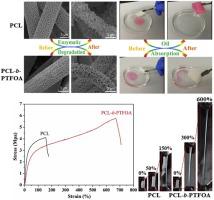当前位置:
X-MOL 学术
›
Prog. Org. Coat.
›
论文详情
Our official English website, www.x-mol.net, welcomes your
feedback! (Note: you will need to create a separate account there.)
A highly stretchable and biodegradable superamphiphobic fluorinated polycaprolactone nanofibrous membrane for antifouling
Progress in Organic Coatings ( IF 6.5 ) Pub Date : 2020-10-01 , DOI: 10.1016/j.porgcoat.2020.105776 Wulong Li , Yakun Zong , Qun Liu , Yi Sun , Zirun Li , Haipeng Wang , Zhanxiong Li
Progress in Organic Coatings ( IF 6.5 ) Pub Date : 2020-10-01 , DOI: 10.1016/j.porgcoat.2020.105776 Wulong Li , Yakun Zong , Qun Liu , Yi Sun , Zirun Li , Haipeng Wang , Zhanxiong Li

|
Abstract A highly stretchable and biodegradable superamphiphobic fluorinated polycaprolactone (PCL-b-PTFOA) nanofibrous membrane with a hierarchical porous surface was prepared via electrospinning. Solvent evaporation-induced phase separation and fluorinated segment migration are the major reasons for the formation of hierarchical porous surface. The introduction of fluorinated segments (PTFOA) greatly improved the superhydrophobic and mechanical properties of the nanofibrous membrane. The superamphiphobic nanofibrous membrane could repel various solutions, including water, acidic, alkaline, coffee, glycol and n-hexane solutions. These solutions were repelled with a small sliding angle of water due to the membrane’s hierarchical pored morphology and low-surface-energy material, as revealed by scanning electron microscopy (SEM), atomic force microscopy (AFM), attenuated total reflectance Fourier transform infrared spectroscopy (ATR-FTIR), X-ray photoelectron spectroscopy (XPS) and energy dispersive X-ray spectroscopy (EDS) analyses. Studies of tensile testing and enzymatic biodegradation were also performed. The simultaneous reinforcing and toughening effect was achieved by the bonding of PTFOA onto the PCL chains, which breaking elongation increases from 152.97 %–678.15 %, and the tensile strength increases from 4.11 to 5.78 MPa. Additionally, the superamphiphobicity of the membrane was not lost with a strain up to 600 %. More importantly, the PCL-b-PTFOA nanofibrous membranes demonstrated excellent enzymatic degradation with 81.1 % weight loss at 37 °C for 24 h with Aspergillus oryzae in a phosphate buffer solution. These results suggest that compared with non-degradable materials, the prepared PCL-b-PTFOA nanofibrous membrane can be used as an excellent biodegradable material with good adaptability for antifouling and self-cleaning.
中文翻译:

用于防污的高度可拉伸和可生物降解的超疏水性氟化聚己内酯纳米纤维膜
摘要 通过静电纺丝法制备了具有分级多孔表面的高度可拉伸和可生物降解的超疏水性氟化聚己内酯(PCL-b-PTFOA)纳米纤维膜。溶剂蒸发引起的相分离和氟化链段迁移是形成分级多孔表面的主要原因。氟化链段(PTFOA)的引入极大地改善了纳米纤维膜的超疏水性和机械性能。超疏水纳米纤维膜可以排斥各种溶液,包括水、酸性、碱性、咖啡、乙二醇和正己烷溶液。如扫描电子显微镜 (SEM) 所揭示,由于膜的分级孔形态和低表面能材料,这些溶液被较小的水滑动角排斥,原子力显微镜 (AFM)、衰减全反射傅里叶变换红外光谱 (ATR-FTIR)、X 射线光电子能谱 (XPS) 和能量色散 X 射线光谱 (EDS) 分析。还进行了拉伸试验和酶促生物降解的研究。通过将 PTFOA 结合到 PCL 链上实现了同时增强和增韧的效果,其断裂伸长率从 152.97 % 增加到 678.15 %,拉伸强度从 4.11 增加到 5.78 MPa。此外,当应变高达 600% 时,膜的超疏水性并未丧失。更重要的是,PCL-b-PTFOA 纳米纤维膜在磷酸盐缓冲溶液中与米曲霉一起在 37°C 下 24 小时显示出优异的酶促降解,重量损失为 81.1%。
更新日期:2020-10-01
中文翻译:

用于防污的高度可拉伸和可生物降解的超疏水性氟化聚己内酯纳米纤维膜
摘要 通过静电纺丝法制备了具有分级多孔表面的高度可拉伸和可生物降解的超疏水性氟化聚己内酯(PCL-b-PTFOA)纳米纤维膜。溶剂蒸发引起的相分离和氟化链段迁移是形成分级多孔表面的主要原因。氟化链段(PTFOA)的引入极大地改善了纳米纤维膜的超疏水性和机械性能。超疏水纳米纤维膜可以排斥各种溶液,包括水、酸性、碱性、咖啡、乙二醇和正己烷溶液。如扫描电子显微镜 (SEM) 所揭示,由于膜的分级孔形态和低表面能材料,这些溶液被较小的水滑动角排斥,原子力显微镜 (AFM)、衰减全反射傅里叶变换红外光谱 (ATR-FTIR)、X 射线光电子能谱 (XPS) 和能量色散 X 射线光谱 (EDS) 分析。还进行了拉伸试验和酶促生物降解的研究。通过将 PTFOA 结合到 PCL 链上实现了同时增强和增韧的效果,其断裂伸长率从 152.97 % 增加到 678.15 %,拉伸强度从 4.11 增加到 5.78 MPa。此外,当应变高达 600% 时,膜的超疏水性并未丧失。更重要的是,PCL-b-PTFOA 纳米纤维膜在磷酸盐缓冲溶液中与米曲霉一起在 37°C 下 24 小时显示出优异的酶促降解,重量损失为 81.1%。











































 京公网安备 11010802027423号
京公网安备 11010802027423号